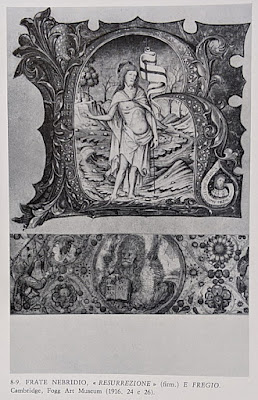Following my blogpost in September in which I virtually reunited a cutting of an illuminated border at Harvard, with an historiated initial at the Fitzwilliam Museum illuminated by the Master of the Murano Gradual, I had a series of email exchanges with Bill Stoneman, which have now borne unexpected but very satisfying fruit.
The Murano border is one of a series of illuminated cuttings at Harvard with consecutive shelfmarks and a common recent provenance, described in detail below. A few of these cuttings have previously been associated with William Young Ottley (especially those with "from the Cathedral of Como" inscriptions, like those discussed in this post), but I can now show that all of them come from the 1838 Ottley sale.
As I mentioned in the post about the Murano Gradual border, it was one of a large group given to the Fogg Art Museum in 1916 by William Augustus White, having previously been in the collection of Robert Hoe. In an addendum to that post (thanks to Bill) I provided the relevant entry in the Hoe auction catalogue, by The Anderson Auction Company, New York, Part IV, 11 November 1912:
| [Source] |
"1913 | Jan'y 3 Vol. of 46 Miniatures 14th-15th-16th centuries, from chorals, missals, &c."
"Lot 2361 4th pt. Hoe sale, of Quaritch (who pd. $700 but would have gone higher) $1200"
"March 24th 1916 | given [to] Fogg Art Museum, Harvard"
 |
| "NEB | RIDI' | ME .P." |
"172 Two—Christ risen from the Dead, Nebrid. Pinx.; and the Transfiguration"
EDIT, 10 January 2021
I was apparently wrong to suggest, above, that the Resurrection and Ascension cuttings were formerly attached to the same sheet, which I based on the reproduction in Bandera's article: an image in Giordana Mariani Canova, ‘Manoscritti Miniati Veneti Nelle Biblioteche Di Cambridge e Boston (Mass.)’, Arte Veneta, 29 (1975), 97–104, shows a different configuration:










No comments:
Post a Comment
** PLEASE INCLUDE YOUR NAME IN YOUR COMMENT **
I may ignore and delete anonymous comments